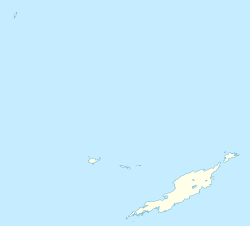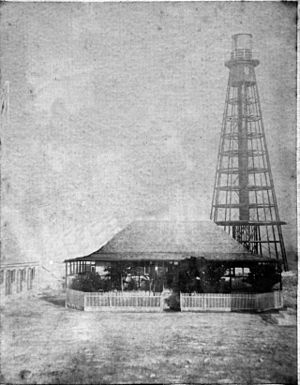Sombrero, Anguilla facts for kids
|
The location of Sombrero within Anguilla
|
|
| Geography | |
|---|---|
| Location | Atlantic Ocean |
| Coordinates | 18°35′21″N 63°25′31″W / 18.58917°N 63.42528°W |
| Archipelago | Antilles |
| Administration | |
|
United Kingdom
|
|
| British Overseas Territory | Anguilla |
| Additional information | |
| Time zone | |
| ISO code | AI |
| Official name: Sombrero Island Nature Reserve Marine Park | |
| Designated: | 22 May 2018 |
| Reference #: | 2354 |
Sombrero, also known as Hat Island, is a small island that is part of Anguilla. Anguilla is a British Overseas Territory, which means it's a special part of the United Kingdom. Sombrero is the most northern island in a group called the Lesser Antilles.
It is about 54 kilometers (33.5 miles) north-west of Anguilla. The island is 1.67 kilometers (1.04 miles) long from north to south and 0.38 kilometers (0.24 miles) wide. Its total land area is about 0.38 square kilometers (94 acres).
When people first saw Sombrero from the sea, it looked like a sombrero hat. However, mining operations changed its shape. Workers dug up a lot of guano, which is bird droppings used as fertilizer. This left the island with steep sides and a flat top. The highest point is about 12 meters (39 feet) above sea level. The island's surface is rough, and there are not many plants growing there.
Guano mining was a big business here. By 1870, about 3,000 tons of phosphate (from guano) were dug up each year. But by 1890, all the phosphate was gone.
Contents
History of Sombrero Island
Sombrero Island became part of the United Kingdom in 1714 after a peace agreement called the Treaty of Utrecht. In 1807, a British naval captain, Warwick Lake, left a sailor named Robert Jeffrey on the island as punishment. Luckily, an American ship rescued Jeffrey later. Captain Lake was removed from the navy for this.
In the early 1800s, British geologists explored the island. They found that it had a lot of guano, which was valuable for farming. In 1856, Americans claimed the island and quickly mined 100,000 tons of phosphate. This phosphate was used as fertilizer in the southern United States.
During this time, something important happened. Workers from the West Indies, who were paid for their work, protested against unfair treatment from an American manager. Four workers were involved in a serious incident with the manager and took control of the island's supplies and money. The British government later stepped in and settled the dispute, confirming that Sombrero belonged to Britain in 1867.
The Sombrero Lighthouse
Sombrero Island is located on a busy shipping route from Britain to South and Central America. This area had many dangers for ships. In 1848, people asked the British Navy to build a lighthouse on the island. After a ship called Paramatta crashed on a nearby reef in 1859, the need for a lighthouse became even clearer. The lighthouse was built and first lit up on January 1, 1868.
Interestingly, both the Paramatta ship and the lighthouse were built by the same company, the Thames Ironworks and Shipbuilding Company, in London.
From the 1870s to 1885, a mining engineer named Thomas Corfield was in charge of the guano operations. He managed the transport of guano to ships, built cranes, and laid tracks for wagons. The guano was simply piled up near the engine houses. There was no proper port or beach.
The workers were Black and came from different islands. They lived in wooden huts while they worked. A ship called Logos brought them to and from their homes and delivered supplies.
The superintendent's house was a wooden bungalow with a wide porch. The superintendent and their family lived there, except during hurricane season. Other wooden buildings for technicians, storekeepers, and lighthouse keepers were grouped around the main house.
In 1890, the guano mining stopped. By 1893, the lighthouse was managed by the British Board of Trade. In 1931, the lighthouse was updated with a brighter light and had its first major repair.
On July 20, 1962, a new lighthouse was built after Hurricane Donna damaged the old one in 1960. The old tower was taken down a week later. The current lighthouse is near the center of the island and is about 166 feet (50.6 meters) tall. It helps guide ships passing from the Atlantic Ocean into the Caribbean Sea. The government of Anguilla took full responsibility for the lighthouse on December 1, 2001.
Population
For a long time, the only people living on Sombrero Island were the lighthouse staff. However, the lighthouse became automated (run by machines) in 2002. Now, no one lives on the island. The only visitors are sometimes fishermen, scientists studying wildlife, or scuba divers exploring the interesting underwater sites.
Wildlife on Sombrero Island
Sombrero Island is home to some special animals. It has a unique lizard called the Sombrero ameiva, which is easy to spot. A tiny gecko, possibly new to science, has been found and is called the Sombrero dwarf gecko. The Anguilla Bank anole lizard also lives here. The island also has a special type of bee called Lasioglossum.
The waters around the island are important feeding areas for hawksbill turtles. Long ago, during the late Ice Age, a giant tortoise called Chelonoidis sombrerensis lived on the island, but it is now extinct.
Sombrero has been named an Important Bird Area by BirdLife International. This is because many seabirds come here to breed. Since 2018, the island has also been a protected Ramsar site, which means it's an important wetland for birds. It supports large numbers of:
- Masked boobies (Sula dactylatra): In 2002, there were 27 pairs (54+ birds), which is 4% of the Caribbean population.
- Brown boobies (Sula leucogaster): In 1999, there were 386 pairs (772+ birds), which is 5% of the Caribbean population.
- Bridled terns (Sterna anaethetus): In 1998, there were 270 pairs (540 birds), which is 4% of the Caribbean population.
- Brown noddies (Anous stolidus): In 1998, there were 700 pairs (1400 birds), which is 5% of the Caribbean population.
- Sooty terns (Onychoprion fuscata)
Images for kids
See also
 In Spanish: Isla Sombrero para niños
In Spanish: Isla Sombrero para niños







